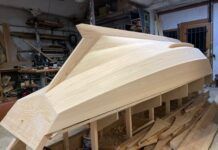When choosing a bottom paint, make sure it is compatible with your existing paint, or be prepared for whatever extra prep work might be required. Usually, all that is required is some light sanding and possibly, a primer coat, although in some cases, more aggressive sanding and surface prep is required.
Second, make sure the paint matches your needs. Most paints are formulated for specific conditions. We loosely classify bottom paints into two categories: hard paints and ablative paints. Hard paints hold up well to underwater cleaning and can usually be burnished smooth for racing. However, they leave behind paint layers that build up and eventually will need to be sanded off. Also, hard paints can require a light sanding before re-launch, or even lose their punch altogether if they are stored ashore for too long. Most ablatives can be hauled and re-launched without worries.
Ablative paints wear away, so they don’t build up paint layers over time. There are two main types-bottom-tier workboat ablatives that slough away to activate more biocide, and more expensive copolymer ablatives that release biocides at a more controlled rate.
Although ablatives are often called soft paints, some, like the new dual-resin ablatives, are relatively hard. These will usually resist light, underwater cleaning and are suitable for trailering.
The hard and ablative paints are further divided into five broad sub-categories that often overlap: freshwater paints, aluminum paints, racing paints, water-based paints (easy for the do-it-yourselfer to apply), and eco-friendly paints. Paint types are indicated in the accompanying tables, and the best paints in each category earn Recommended ratings.
In March 2012 (available online) our report focused on the long-term effectiveness of paints by type. In general, the order of failure is, first to last: freshwater, eco-friendly, low-copper single-season, water-based paints, dual-resin paints, high-copper multi-season ablative, and high-copper multi-season hard. Whether or not a paint has a biocide-booster does not seem to make a significant difference by the two-year mark in our tests, but biocides clearly help combat slime during the first year or so.
For more on selecting paints, see the Inside Practical Sailor blog post Choosing a Bottom Paint for Dummies, which was posted online Aug. 31, 2011.







































